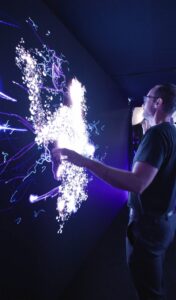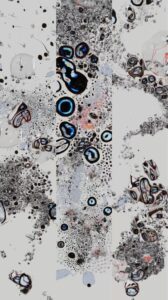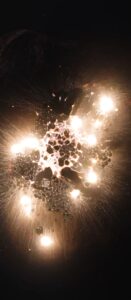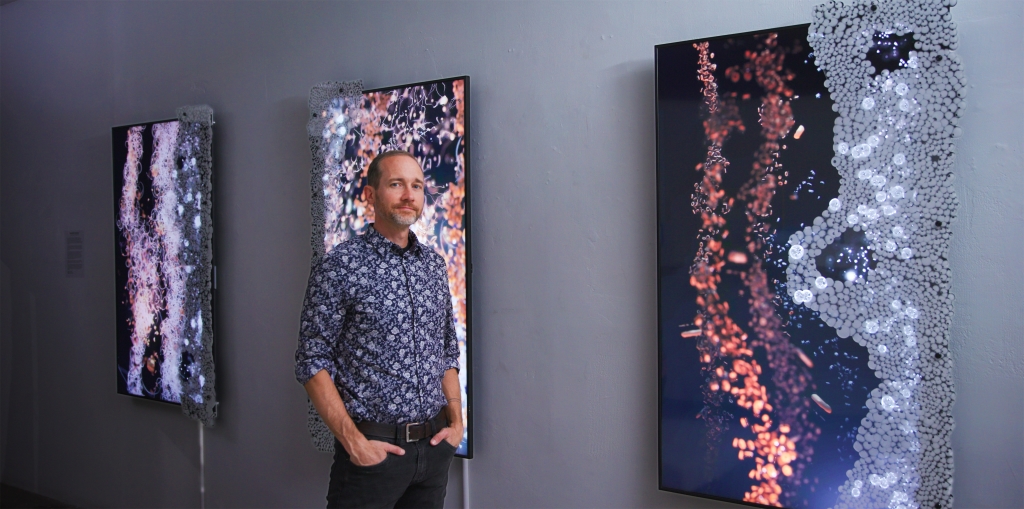Writer Joseph J. Airdo // Photography by David Guerrero, Pixel Thick Productions



In an unassuming art studio in Phoenix, algorithmic processes whir into motion, translating streams of data into abstract visualizations that ebb, flow and metamorphose across digital canvases. For multimedia artist Casey Farina, this automated choreography of light and sound isn’t just a showcase of leading-edge technology — it’s a portal into new frontiers of creative expression.
By harnessing the unpredictable potential of generative systems, Farina sculpts audiovisual worlds that beckon viewers to not just observe, but sometimes also participate.
“I create audiovisual artwork with generative algorithms,” he describes. “I’ve always been fascinated by setting up a series of rules or conditions in a computer and then running that process over and over to observe the results. My work focuses on transcoding digital information between sound and image.”
Farina’s work epitomizes how Arizona, with its blossoming arts scene and technology corridors, has emerged as a vital hub for artists synthesizing code with free-flowing creativity. At the vanguard of this innovative movement, he crafts dynamic experiences that expand how we experience and contextualize art itself.



Computational Creativity
Although Farina’s creative process leverages cutting-edge tools, his inspiration harks back to pioneering 20th-century artists and composers who challenged conventions.
“My artistic path is somewhat unconventional,” he explains. “I started primarily as a musician, earning both my undergraduate and master’s degrees in music. Over time, these elements gradually merged and accumulated along my artistic path.”
An early exposure to the visual programming environment Max/MSP/Jitter, which represents code as interactive diagrams instead of text, kicked off his fascination with generative art. It was an audiovisual demo linking the radical indeterminist philosophies of John Cage with the chaotic tonal experiments of researcher John Chowning’s frequency modulation synthesis that revealed deeper possibilities.
“Chowning’s FM techniques exhibit wild, unpredictable results when creating new sounds — not unlike incorporating randomness and relinquishing total control,” Farina describes. “In this computer example, frequency modulation was combined with indeterminacy, or relinquishing control. Instead of manually adjusting parameters, the computer-generated random numbers and the output were curated.”
By setting initial conditions but then ceding authorship to autonomous computer processes, Farina brings those avant-garde concepts into a contemporary framework.
“My recent show ‘Possibility Spaces’ reflected this theme of engaging indeterminacy, shaping the process and curating its output,” he says. “My algorithmic practice produces audiovisual artworks composed of entities that move and produce sound. As these entities interact with each other in unexpected ways I am looking for “emergent behavior” or “happy accidents” that are aesthetically compelling.”



Interactive Innovations
While Farina’s generative processes automate aspects of image and sound generation, his role transforms into an active curator and composer of the results. His works even sometimes incorporate interactive elements that enable each participant’s indirect influence to alter the experience.
In 2020, Scottsdale Arts invited Farina to showcase two of his innovative works — “Across the Divide” and “Keeping Time” — during Canal Convergence, an annual temporary outdoor exhibition of innovative, large-scale public art installations by local, national and international artists.
He returned to the event the following year with another installation: “Time Stream.” Jennifer Gill, deputy director at Scottsdale Arts’ Canal Convergence, describes the artwork as having been an interactive digital environment that provided an instant reaction to the viewer’s movements in the digital sphere.
“This use of technology combined with the color, form and movement of the piece created a sense of not just joy and awe for participants but also curiosity,” Gill explains. “From here, people could choose to continue to engage with the piece and discover its deeper meaning relating to time and the ‘butterfly effect.’”
She adds that combining immersive technologies with layers of artistic expression and meaning made for an exemplary installation for Canal Convergence, which she notes serves as an inclusive entry point into the art world that welcomes people of all ages, genders and backgrounds.
“By combining his abstract visual language with projection and interactive technology, Casey’s work successfully opens the door to the public in both a fun and thoughtful way,” says Gill, underscoring how participatory technology is one of the core components that makes Canal Convergence such a unique and engaging experience.
“These types of technologies allow artists to engage the public in a truly unique way, creating powerful memories and experiences that can stimulate the mind and reframe the definition of art itself. Casey’s exploration of randomness and indeterminacy through abstract forms and movement speaks to an exceptional interpretation of our event themes, presenting a new perspective with each iteration he participated in.”
Crucially, Farina rejects the notion of imparting any singular message or intentional meaning into his works.
“When I create art, I don’t approach it with a specific message in mind,” he says. “The traditional artist-audience relationship, where artists create art and people simply observe it, doesn’t fully resonate with me. While I understand the complexities of this dynamic, I believe that the richness of individual experiences and interpretations transcends any singular message or explanation I could provide.”



Artistic Assistance
As artificial intelligence capabilities accelerate, new creative prospects and philosophical quandaries have emerged regarding computational co-creation. Farina has actively explored the roles AI could play, from generating images based on text prompts to automating programming tasks, and remains optimistic about AI’s creative potential when integrated thoughtfully by human artists.
“In the art world, those using AI as a tool in a larger process create the most interesting work,” says Farina, adding that he has found applications like Stable Diffusion useful for rapidly prototyping code. “I can now generate syntactically correct code for specific tasks, with only minor adjustments needed. This has significantly increased my productivity.”
Ultimately, Farina believes AI’s ascendance won’t replace human artistic expression but will become another tool in the creative arsenal of artists exploring new mediums — an extension of the generative processes he currently wields.
“Stephen Wolfram’s work, particularly his book ‘A New Kind of Science,’ has greatly influenced my recent work,” Farina shares. “His research into cellular automata, which produce emergent behavior from simple rules, inspired me to develop meta systems that generate multiple layers of complexity.”
“Cellular automata, often visualized as black and white grids, can create patterns found in nature, such as those on turtle shells or conch shells. However, the mechanism behind the manifestation of patterns in the real world is still unknown. In exploring cellular automata rules, Wolfram discovered irreducible phenomena, which are unpredictable and lack traditional scientific shortcuts. The manifestation of art, rather than just the idea, is still necessary, and there’s no shortcut to creating art by simply typing a prompt into an AI. I believe the artistic process is irreducible.”
At the intersection of human ingenuity and computational prowess, Farina’s pioneering multimedia works reveal shimmering new aesthetic realms. By sculpting audiovisual experiences that unfurl based on systematized rules yet allow space for randomness, evolution and personal connection, his artistic practice manifests an ethos of perpetual curiosity and openness to possibility itself.
As his portfolio continues to evolve and inspire, Farina welcomes commissions and purchase inquiries via email at caseyfarina@gmail.com.







Comments by Admin